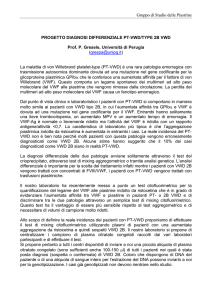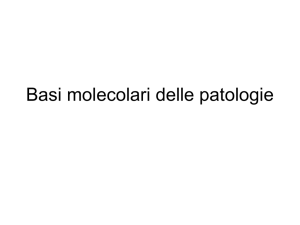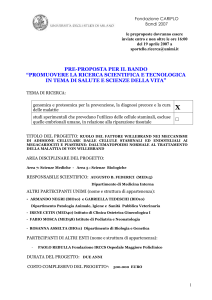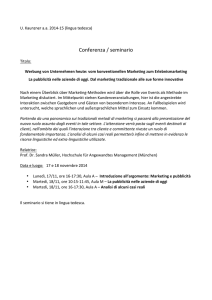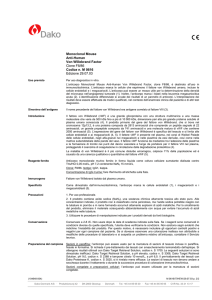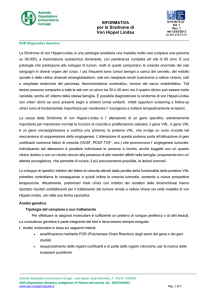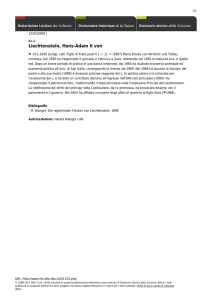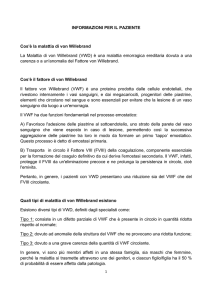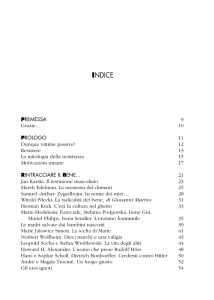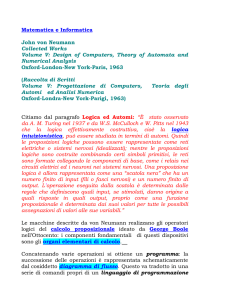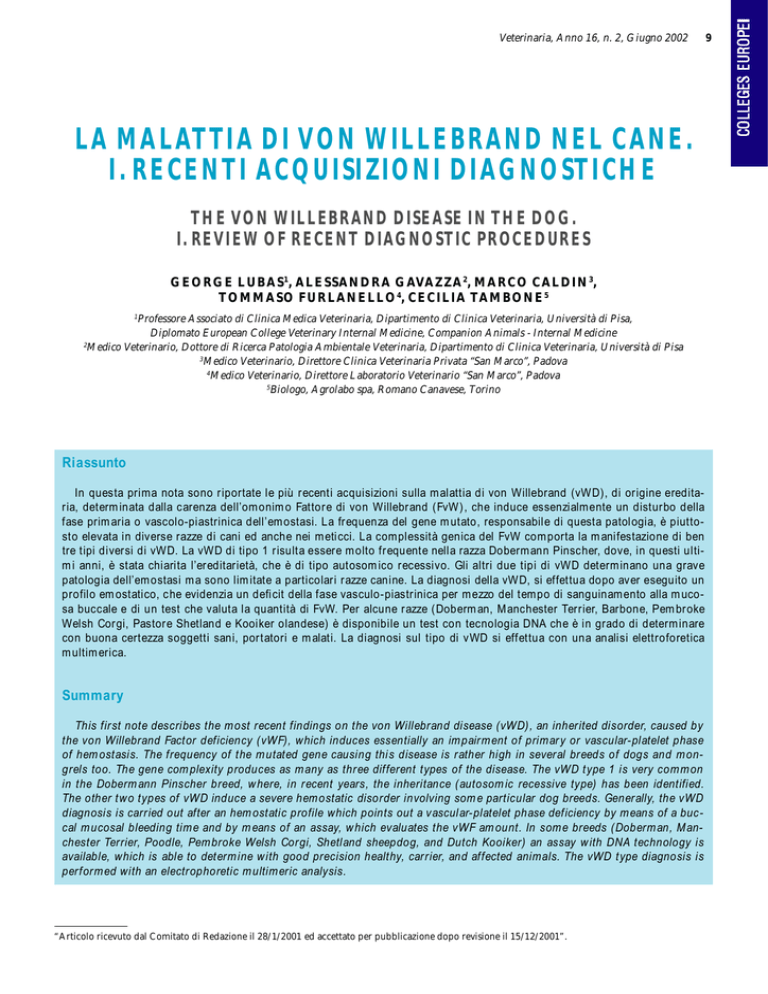
Veterinaria, Anno 16, n. 2, Giugno 2002
LA MALATTIA DI VON WILLEBRAND NEL CANE.
I. RECENTI ACQUISIZIONI DIAGNOSTICHE
THE VON WILLEBRAND DISEASE IN THE DOG.
I. REVIEW OF RECENT DIAGNOSTIC PROCEDURES
GEORGE LUBAS1, ALESSANDRA GAVAZZA2, MARCO CALDIN3,
TOMMASO FURLANELLO4, CECILIA TAMBONE5
Professore Associato di Clinica Medica Veterinaria, Dipartimento di Clinica Veterinaria, Università di Pisa,
Diplomato European College Veterinary Internal Medicine, Companion Animals - Internal Medicine
2
Medico Veterinario, Dottore di Ricerca Patologia Ambientale Veterinaria, Dipartimento di Clinica Veterinaria, Università di Pisa
3
Medico Veterinario, Direttore Clinica Veterinaria Privata “San Marco”, Padova
4
Medico Veterinario, Direttore Laboratorio Veterinario “San Marco”, Padova
5
Biologo, Agrolabo spa, Romano Canavese, Torino
1
Riassunto
In questa prima nota sono riportate le più recenti acquisizioni sulla malattia di von Willebrand (vWD), di origine ereditaria, determinata dalla carenza dell’omonimo Fattore di von Willebrand (FvW), che induce essenzialmente un disturbo della
fase primaria o vascolo-piastrinica dell’emostasi. La frequenza del gene mutato, responsabile di questa patologia, è piuttosto elevata in diverse razze di cani ed anche nei meticci. La complessità genica del FvW comporta la manifestazione di ben
tre tipi diversi di vWD. La vWD di tipo 1 risulta essere molto frequente nella razza Dobermann Pinscher, dove, in questi ultimi anni, è stata chiarita l’ereditarietà, che è di tipo autosomico recessivo. Gli altri due tipi di vWD determinano una grave
patologia dell’emostasi ma sono limitate a particolari razze canine. La diagnosi della vWD, si effettua dopo aver eseguito un
profilo emostatico, che evidenzia un deficit della fase vasculo-piastrinica per mezzo del tempo di sanguinamento alla mucosa buccale e di un test che valuta la quantità di FvW. Per alcune razze (Doberman, Manchester Terrier, Barbone, Pembroke
Welsh Corgi, Pastore Shetland e Kooiker olandese) è disponibile un test con tecnologia DNA che è in grado di determinare
con buona certezza soggetti sani, portatori e malati. La diagnosi sul tipo di vWD si effettua con una analisi elettroforetica
multimerica.
Summary
This first note describes the most recent findings on the von Willebrand disease (vWD), an inherited disorder, caused by
the von Willebrand Factor deficiency (vWF), which induces essentially an impairment of primary or vascular-platelet phase
of hemostasis. The frequency of the mutated gene causing this disease is rather high in several breeds of dogs and mongrels too. The gene complexity produces as many as three different types of the disease. The vWD type 1 is very common
in the Dobermann Pinscher breed, where, in recent years, the inheritance (autosomic recessive type) has been identified.
The other two types of vWD induce a severe hemostatic disorder involving some particular dog breeds. Generally, the vWD
diagnosis is carried out after an hemostatic profile which points out a vascular-platelet phase deficiency by means of a buccal mucosal bleeding time and by means of an assay, which evaluates the vWF amount. In some breeds (Doberman, Manchester Terrier, Poodle, Pembroke Welsh Corgi, Shetland sheepdog, and Dutch Kooiker) an assay with DNA technology is
available, which is able to determine with good precision healthy, carrier, and affected animals. The vWD type diagnosis is
performed with an electrophoretic multimeric analysis.
“Articolo ricevuto dal Comitato di Redazione il 28/1/2001 ed accettato per pubblicazione dopo revisione il 15/12/2001”.
9
10
La Malattia di von Willebrand nel cane. I. Recenti acquisizioni diagnostiche
DEFINIZIONE ED EPIDEMIOLOGIA
TERMINOLOGY AND EPIDEMIOLOGY
La malattia di von Willebrand (vWD = von Willebrand
Disease) è la patologia ereditaria dell’emostasi di frequente
riscontro nel cane ed è stata segnalata in oltre 54 razze diverse, con una elevata prevalenza in quella Dobermann (Tab.
1). Questa malattia è caratterizzata dalla diminuzione o dalla
mancanza dell’omonimo fattore della coagulazione (FvW=
Fattore di von Willebrand), che ricopre un ruolo determinante sia nell’emostasi primaria che in quella secondaria1-9.
The von Willebrand disease (vWD) is an inherited
disorder of hemostasis widely found in dogs. vWD has
been reported in more over than 54 different breeds,
with a particular high prevalence in the Dobermann
(table 1). A reduction or absence of the von Willebrand Factor (vWF), which covers a fundamental role
in both primary and secondary hemostasis, characterizes this disease1-9.
EZIOPATOGENESI
ETIOPATHOGENESIS
Il FvW è una glicoproteina multimerica ad attività adesiva
composta da subunità polipeptidiche di 270 kDa (kiloDalton) legate tra loro da ponti disulfuro, in modo da formare
The vWF is a multimeric glycoprotein with adhesive
activity, composed by polypeptidic subunits of 270
Tabella 1
Prevalenza (espressa in percento) della Malattia di von Willebrand (vWD) in varie razze canine5, 6
Dobermann*
Basset Hound
Keeshound
Pastore Shetland
Rottweiler
Razze con elevata prevalenza del gene vWD (15-80%)
Airdale terrier
Bassotto, Bassotto nano
Manchester Terrier
Pastore Tedesco
Schnauzer nano
Akita inu
Bearded Collie
Boxer
Cocker Spaniel Americano
Fox Terrier
Irish Wolfhound
Levriero italiano
Pastore Pirenei
Samoyedo
Setter Irlandese
Tibetan Terrier
Whippet
Razze con ridotta od incerta prevalenza del gene vWD
Alaskan Malamute
Bichon Frisé
Cairn Terrier
Cocker Spaniel Inglese
Kerry Blue Terrier
Lakeland Terrier
Lhasa Apso
Pointer Tedesco (sh & wh)
Schnauzer gigante
Shih Tzu
Vizsla
Yorkshire Terrier
Barbone, Barbone nano
Golden Retriever
Manchester Toy Terrier
Pembroke Welsk Corgi
Scottish Terrier
Alano
Bovaro Bernese
Chesapeake Bay Retrevier
Dutch kooiker
Kuvazs
Levriero afgano
Papillon
Rough collie
Setter Inglese
Siberian Husky
Wheaton Terrier
* = termine impiegato per il Dobermann Pinscher in questo lavoro; l’elenco è compilato per ordine alfabetico.
Table 1
Prevalence (expressed as percentage) of von Willebrand disease (vWD) in several dog breeds5, 6
Dobermann*
Duchshund toy & standard
Golden Retriever
Poodle toy & standard
Schnauzer miniature
Breeds with high prevalence of vWD gene (15-80%)
Airdale terrier
Manchester Terrier toy & standard
Keeshound
Rottweiler
Shetland Sheepdog
Basset Hound
German Shepherd
Pembroke Welsk Corgi
Scottish Terrier
Afghan hound
American Cocker Spaniel
Bichon Frisé
Chesapeake Bay Retrevier
English Setter
German Pointer (sh & wh)
Greyhound
Italian Greyhound
Labrador retriever
Papillon
Shih Tzu
Tibetan Terrier
Whippet
Breeds with low or uncertain prevalence of vWD gene
Akita inu
Bearded Collie
Boxer
Dutch kooiker
English springer spaniel
Great Dane
Irish Setter
Kerry Blue Terrier
Lakeland Terrier
Rough collie
Siberian Husky
Vizsla
Yorkshire Terrier
Alaskan Malamute
Bernese mountain dog
Cairn terrier
English Cocker Spaniel
Fox Terrier
Great Pyrenees
Irish Wolfhound
Kuvazs
Lhasa Apso
Samoyedo
Schnauzer (giant)
Wheaton Terrier sc
* = statement used for Dobermann Pinscher in this report; the list is reported in alphabetic order
Veterinaria, Anno 16, n. 2, Giugno 2002
11
sia elementi a basso che ad elevato peso molecolare (multimeri da 0,5 fino a 20 milioni di Da). Il FvW è sintetizzato ed
assemblato primariamente nelle cellule endoteliali e secondariamente nei megacariociti. A livello delle cellule endoteliali viene immagazzinato nei corpi di Weibel Palade e una
quantità veramente minima si rinviene nei granuli alfa delle
piastrine e dei megacariociti. In genere, i multimeri ad elevato peso molecolare, in deposito, hanno una più elevata attività emostatica, rispetto ai multimeri a basso peso molecolare (dimeri o polimeri) circolanti. La secrezione dalle riserve
nelle cellule endoteliali è indotta da istamina, vasopressina,
trombina, fibrina ed estrogeni, mentre la liberazione dalle riserve delle piastrine è stimolata da collagene, ADP, fattore
attivante le piastrine (PAF), adrenalina e trombina5, 10.
Il FvW favorisce l’adesione delle piastrine al subendotelio o
su altre superfici trombogeniche mediante un legame con la
glicoproteina di superficie piastrinica Ib-IX (Gp Ib-IX). Inoltre, interviene nell’aggregazione piastrinica tramite l’interazione con i recettori di membrana piastrinica GpIIb/IIIa, chiamati integrine alfa IIb/beta 3, che hanno anche attività recettoriale verso il fibrinogeno e la fibronectina. I multimeri ad alto peso molecolare, avendo un maggior numero di siti di legame con cui poter interagire con le piastrine, sono emostaticamente più attivi. Infine, il FvW è l’indispensabile trasportatore
della molecola FVIII, poiché sembra proteggerla dalla proteolisi, prolungandone così l’emivita in circolo5.
TIPI DI MALATTIA DI VON WILLEBRAND
La vWD è determinata da mutazioni ereditarie del gene
vW che si esprimono fenotipicamente nel cane in tre tipi
principali (Tab. 2).
Nella vWD di tipo 1 (in precedenza erano usati i numeri romani), la forma più frequente nella maggior parte delle razze, vi è una anormalità di tipo quantitativo, cioè una
carenza generalizzata, in alcuni casi minima, dei diversi
multimeri del FvW3, 11. Per molto tempo, si è ritenuto che
fosse trasmessa in modo autosomico dominante a penetranza incompleta1, 8, 12. Dopo la caratterizzazione genetica,
è stata stabilita la trasmissione come autosomica recessiva,
ma solo per le razze Dobermann, Manchester terrier, Barboncino e Pembroke Welsh Corgi13-16. Per le altre razze canine, rimane al momento valida l’ipotesi che si tratti di un
gene autosomico dominante a penetranza incompleta e tra
l’altro viene ancora riproposta questa stessa modalità in alcuni recenti lavori anche nel Dobermann17, 18.
La forma di vWD di tipo 2 è caratterizzata da un difetto
di tipo qualitativo, in quanto mancano solo i multimeri a
più alto peso molecolare, emostaticamente più attivi. Per
l’identificazione certa di questo tipo di difetto occorre
un’analisi multimerica. Il difetto genetico è trasmesso in
forma autosomica recessiva nel Pointer Tedesco a pelo
corto e a pelo ruvido19, 20.
Infine la vWD di tipo 3, la più grave, ma anche la più rara,
è trasmessa in modo autosomico recessivo, ed è caratterizzata dalla mancanza assoluta e generalizzata del FvW. È stata
segnalata come problema familiare nel Pastore delle Shetland, Scottish Terrier, Chesapeake Bay retriever e Dutch
Kooiker21-26. Inoltre, come segnalazione sporadica viene riportata nel Border collie, Bull terrier, Cocker spaniel, Labrador retriever, Volpino di Pomerania e nei meticci3.
FIGURA 1 - Sul danno vascolare avviene l’adesione delle piastrine al subendotelio. Il legame delle piastrine si verifica tramite i recettori piastrinici della glicoproteina Ib, mediati dal fattore di von Willebrand. Poiché
i multimeri di von Willebrand a peso molecolare maggiore hanno un
elevato numero di siti di legame sono più efficaci nell’adesione rispetto
ai multimeri a basso peso molecolare.
FIGURE 1 - On the vascular damage occurs the platelet adherence to
the subendothelium. The binding of platelets engages platelet glycoprotein Ib receptors and is mediated by von Willebrand factor. Because
they have more binding sites than do smaller multimers, large von Willebrand factor multimers are more effective in adhering to the subendothelium.
kDA (kiloDalton) linked all together by disulfure
bonds, in such a way to constitute both low and high
molecular weight elements (multimers from 0.5 to 20
millions of DA). The vWF is synthetized and assembled primarily in endothelial cells and secondarily in
megakaryocytes. In endothelial cells, vWF is stored in
the Weibel Palade bodies and very low amounts of
vWF are present in alpha granules of both platelets and
megakaryocytes. Generally, stored high molecular weight multimers have a higher hemostatic activity in com parison to circulating low molecular weight multimers
(dimers or polymers). The secretion from endothelial
cells stores is induced by histamine, vasopressin, thrombin, fibrin, and oestrogens, whereas the releasing
from the platelets storages is stimulated by collagen,
ADP, platelet activating factor (PAF), adrenaline, and
thrombin5, 10.
The vWF allows the platelet adhesion to the subendothelium or upon other thrombogenic surfaces by
12
La Malattia di von Willebrand nel cane. I. Recenti acquisizioni diagnostiche
Tabella 2
Caratteristiche dei diversi tipi di vWD5
tipo
vWD
eredità
segni clinici
multimeri FvW
elevato PM
multimeri FvW
basso PM
FVIII:C
frequenza *
razze più colpite
tipo 1
autosomica dominante
incompleta
moderati
↓↓
↓↓
N / ↓↓
↑↑
Golden Retriever,
Schnauzer
tipo 1
autosomica recessiva
moderati
↓↓
↓↓
N / ↓↓
↑↑
Dobermann,
Manchester Terrier**
tipo 2
autosomica recessiva
gravi
↓↓
non rilevabili
ignoto
↓↓ ↓↓
Pointer Tedesco
tipo 3
autosomica recessiva
gravi
non rilevabili
non rilevabili
↓↓
moderata
Scottish Terrier
FVIII:C = fattore VIII ad attività procoagulante; PM = peso molecolare; N= normale; ↑↑= alto ↓↓ = basso; ↓↓↓↓ = molto basso; * = si intende nelle razze più
colpite; ** = ed anche Barbone e Pembroke Welsh Corgi
Table 2
Features of the several vWD types5
vWD type inheritance
clinical signs
vWF multimers
high MW
vWF multimers
low MW
FVIII:C
frequency **
commonly breeds
affected
type 1
autosomal incomplete
dominant
moderate
↓↓
↓↓
N / ↓↓
↑↑
Golden Retriever,
Schnauzer
type 1
autosomal recessive
moderate
↓↓
↓↓
N / ↓↓
↑↑
Dobermann,
Manchester Terrier*
type 2
autosomal recessive
severe
↓↓
not detectable
unknown
↓↓ ↓↓
German Pointer
type 3
autosomal recessive
severe
not detectable
not detectable
↓↓
moderate
Scottish Terrier
FVIII:C = factor VIII with pro-coagulant activity; MW = molecular weight; N= normal; ↑↑ = high; ↓↓ = low; ↓↓↓↓ = very low; * = in the most commonly affected breeds; ** = also Poodle and Pembroke Welsh Corgi
A tutt’oggi, non è stata dimostrata nel cane una forma acquisita di vWD, sebbene sia sospettata. In seguito ad un lavoro di correlazione tra i dosaggi di FvW e di ormone tiroideo, fu sospettata una relazione tra vWD ed ipotiroidismo 27.
Ulteriori indagini hanno permesso di stabilire che non esiste
un collegamento diretto tra le due patologie, ma che la vWD
e l’ipotiroidismo si manifestano come eventi genetici predisponenti nell’ambito delle medesime razze canine4.
La sintomatologia della vWD è estremamente variabile ed
è legata ai meccanismi ereditari ed al fatto che il FvW è coinvolto essenzialmente nell’emostasi primaria e parzialmente in
quella secondaria. Inoltre, la quantità di FvW presenta delle
fluttuazioni fisiologiche (stress, esercizio fisico, gravidanza,
calore) e patologiche (disendocrinie, neoplasie, processi flogistici etc.), come anche delle oscillazioni derivanti dalla tecnica
di prelievo ematico e dalla preparazione del campione per la
sua determinazione quantitativa28, 29.
Nel cane Dobermann, che manifesta in assoluto la maggiore prevalenza della vWD, grazie agli studi sul DNA, i
soggetti omozigoti per il gene mutante vWD (di tipo 1) risultano essere a serio rischio di manifestare sintomi clinici,
specialmente a seguito di traumatismi o durante interventi
chirurgici banali, come ad es. la caudectomia o la conchectomia, mentre questa evenienza è difficile negli eterozigoti.
Nelle razze che presentano la vWD di tipo 2 e 3, i soggetti
omozigoti manifestano sempre forme gravi di patologie
means of a connection with a platelet surface glycoprotein Ib-IX (Gp Ib-IX). Moreover, vWF mediates the
platelet aggregation by means of an interaction with the
platelet membrane receptors GpIIb/IIIa, called alpha
IIb/beta 3 integrins, which have also receptorial activity toward both fibrinogen and fibronectin. The high
molecular weight multimers, having a higher number
of binding sites, which can interact with platelets, are
more active in hemostasis. Finally, vWF is the essential
carrier of FVIII molecule, because it seems to protect
FVIII from proteolysis, increasing its half-life in the
circulation5.
VON WILLEBRAND DISEASE TYPES
The vWD is caused by genetic mutations in the vW
gene. In the dog the genetic mutations are phenotypically exhibited in three main types (table 2).
In the vWD type 1 (previously, cardinal numbers
were used), the more common form in most of dog’s
breeds, there is a quantitative type anomaly, namely a
generalized deficiency, in some cases minimal, of the
several vWF multimers 3, 11. For long time, this form has
been thought to be inherited as dominant autosomal
Veterinaria, Anno 16, n. 2, Giugno 2002
dell’emostasi. La diatesi emorragica tipica della vWD interessa frequentemente le mucose con quadri di epistassi,
gengivorragie, ematuria e melena; meno sovente si hanno
emorragie cavitarie come ad es. emartri od ematomi cutanei. Talvolta, è stata segnalata la comparsa di una claudicazione a carico degli arti posteriori, dovuta alla presenza di
tessuto eterotopico osseo nelle masse muscolari, come risultato di emorragie a carico dei vasi muscolari e periostali
con successiva organizzazione del coagulo1-9, 12, 30.
DIAGNOSI
La diagnosi della malattia di von Willebrand si poggia sugli
esami di laboratorio ed infatti l’esecuzione di un profilo emostatico permette di inquadrare inizialmente il problema come
un difetto della fase primaria della emocoagulazione1-9.
La lista degli esami per l’inquadramento diagnostico iniziale
deve includere la conta piastrinica e quindi il tempo di sanguinamento della mucosa buccale o Tempo di Emorragia (BMBT
= Buccal Mucosal Bleeding Time) che risulta generalmente allungato nella vWD. Il Tempo di Protrombina (PT) nella vWD
è normale ed il Tempo di Tromboplastina Parziale attivato
(aPTT) è normale o modicamente allungato. La conta delle
Piastrine (Plt) ed il dosaggio dei Prodotti di Degradazione della Fibrina/Fibrinogeno (FDP) sono entrambi nella norma2, 5.
La diagnosi specifica della vWD si basa sulla determinazione quantitativa dell’antigene FvW (FvW:Ag), mediante
una tecnica ELISA. Sul mercato ne esistono alcune varianti, sotto forma di kit commerciali 31-34. Nella valutazione del
risultato quantitativo ottenuto, occorre tenere conto dei
diversi interferenti pre-analitici dovuti sia al paziente che
al campione. Le altre tecniche, come ad esempio la immunoelettroforesi detta ‘Laurell rocket’ (EIA), o l’aggregazione piastrinica alla ristocetina o alla botrocetina sono state
ormai abbandonate perché troppo laboriose od
imprecise5. Di recente, è stato validato per la specie canina
un sistema composto da uno strumento e da apposite cartucce contenenti collagene o ADP (PFA-100TM, Boehring),
nel quale il processo di adesione ed aggregazione piastrinica legato ad un danno vascolare viene simulato in vivo. Il
sistema è risultato valido anche per uno screening di base,
in corso di vWD, utilizzando solamente l’attivatore dell’aggregazione ADP35. Invece, l’analisi elettroforetica su
gel di agarosio (analisi multimerica) serve a caratterizzare
il tipo di vWD, identificando se la carenza coinvolge solo i
multimeri ad alto PM o se invece sia generalizzata5, 10.
Infine, per alcune razze di cani (Dobermann, Manchester Terrier, Barbone, Pembroke Welsh Corgi, Pastore
Shetland e Kooiker olandese) sono disponibili alcuni test
con tecnologia DNA (mediante l’uso sia di marker intragenici che di marker localizzati vicino al gene vW), che permettono di identificare i soggetti malati. Queste analisi sono soprattutto utili nei soggetti eterozigoti che risultano
difficili da riconoscere con la sola analisi quantitativa, anche se vi sono a disposizione altre indagini cliniche e laboratoristiche3, 14, 36, 37 . Questi test sono utilissimi per la scelta
dei riproduttori, al fine di identificare correttamente i soggetti eterozigoti che possono avere ancora una quantità di
FvW compatibile con una funzionalità emostatica accettabile, che non provoca sintomi clinici, se non concorrono
altre patologie emostatiche ad aggravare il quadro.
13
mode with incomplete penetrance1, 8, 12 . After the genetic characterization, the inheritance as recessive autosomal has been established, including Dobermann, Manchester terrier, Poodle, and Pembroke Welsh Corgi
breed only 13-16. For the other dog breeds, the hypothesis as a dominant autosomal gene with incomplete penetrance remains at the moment as accepted explanation. This hypothesis has been still proposed in recent
papers regarding the Dobermann breed17, 18.
The vWD type 2 is characterized by a qualitative defect, because the high molecular weight multimers, more active hemostatically, are missing. The certain identification of this type of defect needs a multimeric analysis. The genetic defect is inherited as recessive autosomal mode in the German Pointer, both short-haired
and wire-haired19, 20.
Finally the vWD type 3, the most severe, but also the
most rare condition, is inherited as autosomal recessive, and it is characterized by absolute and generalized
vWF lacking. This type has been reported as a familial
problem in the Shetland sheepdog, Scottish Terrier,
Chesapeake Bay retriever, and Dutch Kooiker21-26. Moreover, as a sporadic report is described in the Border
collie, Bull terrier, Cocker spaniel, Labrador retriever,
Pomeranian, and mixed breed3.
Up today, an acquired form of vWD has not been
demonstrated in dogs. However, it has been suspected.
After a paper, considering vWF and thyroid hormone
dosages, a relationship was suspected between vWD
and hypothyroidism27. Further investigations established that no direct relationship between these two disorders exists, but both vWD and hypotiroidism are
occurring in the same dog breeds as predisposing genetic event4.
The vWD clinical findings are extremely variable
and they are linked mainly to the hereditary mechanism and due to the fact that vWF is involved essentially in primary hemostasis, and partially in secondary
hemostasis as well. Moreover, vWF amount shows
physiological (stress, physical exercise, pregnancy,
heat) and pathological (endocrine disturbances, tumours, inflammatory diseases, etc.) fluctuations. Variation could be also derive from the blood collection
technique and sample preparation for the assay measuring28, 29.
In the Dobermann dog, which has absolutely the
highest prevalence of the disease, thanks to the DNA
studies, the homozygote subjects for the type 1 vWD
mutant gene, are at serious risk to show the clinical
symptoms. The homozygotes are at risk, particularly
after a trauma or during standard surgery procedures
such as i.e. tail or ear cutting. This occurrence is rare
in the heterozygote animals. In the breeds having the
vWD type 2 or type 3, the homozygote subjects
always show severe forms of hemostasis disorders.
The typical vWD hemorrhagic disturbance involves
commonly the mucosal surfaces with epistaxis, gengival bleeding, hematuria, and melena. Less frequently,
animals have hemorrhage in cavities such as hemarthrosis and cutaneous hematomas. Occasionally, the oc-
14
La Malattia di von Willebrand nel cane. I. Recenti acquisizioni diagnostiche
Gli estensivi studi sulla genetica molecolare della vWD
hanno permesso di chiarire la natura della mutazione responsabile della patologia nel cane di razza Dobermann.
Si tratta di una mutazione sul sito di giunzione, e la giunzione alternativa mutata si manifesta in circa il 90-95% dei
casi. Questo spiega perché l’eredità della vWD nel Dobermann per lungo tempo è stata oggetto di dibattito e fornisce l’evidenza che questa razza presenta una forma più lieve di malattia rispetto ad es. allo Scottish Terrier14.
Il cane Dobermann malato ha due copie del gene mutato.
Ciascuna copia è capace di produrre ancora il 5-10% del
FvW. Ciò avviene, perché talora è impiegata una parte del
gene senza la mutazione giunzionale, che consente questa attività residua di FvW. Invece, se viene usata la copia con incluso il sito di giunzione mutato non si produce affatto FvW
e ciò si verifica nel 90-95% dei casi. Dal momento che, complessivamente ciascun gene mutato, può produrre comunque un 5-10% di FvW, il Dobermann affetto ne ha dose
doppia, cioè ha il 10-20% di FvW nel sangue. Gli animali
malati con questa ridotta e residua attività di FvW, saggiati
per il FvW:Ag con vari test analitici, risultavano avere valori,
intorno al 10-20%, senza però avere nessuna anamnesi di
sanguinamento. Infatti, se questi soggetti erano sottoposti a
chirurgia, e la quantità di perdita ematica non era troppo
elevata, non era registrato alcun sanguinamento incontrollato. Ciò non significa che la vWD nel Dobermann non sia pericolosa. Infatti, la letteratura è ricca di segnalazioni di gravi
sanguinamenti imprevedibili nella razza Dobermann, talora
responsabili anche di morte. Vi sono una serie di fattori, noti
ed ignoti, che influenzano il decorso clinico in un determinato paziente. Per primo i fattori della coagulazione, tra cui il
FvW che sono consumati durante l’emostasi. Infatti, più elevato è il sanguinamento da una ferita accidentale o chirurgica, più risulta alto il loro consumo. Quindi, è possibile che la
limitata disponibilità di FvW in un Dobermann affetto sia
completamente utilizzata, inducendo un nuovo sanguinamento, stavolta provocato dalla deficienza di FvW. Inoltre,
c’è anche una variazione consistente della quantità di FvW
nei Dobermann affetti. Un cane con un valore del 5% di
FvW:Ag è a rischio più elevato di quello con il 15%. Pertanto, altre componenti, come ad es. fattori tessutali o della coagulazione che non vengono misurati e variano da un soggetto all’altro, inducono una differenza nel rischio di sanguinamento in una particolare situazione e la vWD deve essere tenuta in considerazione come un rischio significativo14, 18.
La frequenza del gene della vWD nel Dobermann allevato
negli USA è riportato essere oltre il 60%, ma ciò non fornisce una misura corretta del problema. Da questa stima, assumendo allora una frequenza genica di 0,6 (cioè il 60% dei
geni sono mutanti), ed impiegando la legge di Hardy-Weinberg, è possibile calcolare la frequenza dei diversi fenotipi
nei Dobermann. Quindi, circa il 36% sono omozigoti ed affetti (doppia dose del gene mutato, con rischio di sanguinamento da lieve a moderato), il 48% sono portatori (un gene
normale ed uno mutante, senza effettivo rischio di sanguinamento) ed un 16% sono omozigoti sani (doppia dose di gene normale). Dai risultati sullo studio con tecnologia DNA
condotto su 3.207 Dobermann i valori furono i seguenti:
esenti 28,1%, portatori 48,9%, affetti 23,0%, così la frequenza genica del gene vWD era di 0,47436.
I portatori del gene mutante non sono a rischio di sanguinamento per la vWD, ma ovviamente trasmettono il gene
currence of gait abnormality localized to rear limbs
has been reported, due to the presence of bone heterotopic tissue in the muscular mass, as the result of
hemorrhage involving muscular and periosteal vessels with subsequent organization of the blood clot 19, 12, 30
.
DIAGNOSIS
The diagnosis of vWD is based on the laboratory
exams. Indeed, the hemostatic profile allows to classify
initially the problem as a defect of the primary phase of
hemocoagulation1, 9.
The list of exams for the initial diagnostic classification should include the platelet count and then the
buccal mucosal bleeding time (BMBT) which results
generally prolonged in vWD. The Prothrombin time
(PT) is normal in vWD, and the activated Partial Thromboplastin Time is either normal or slightly prolonged in vWD. The platelet (Plt) count and the
Fibrin/ogen Degradation Products (FDP) are both
normal in vWD2, 5.
The specific diagnosis of vWD is based on the
amount detection of vWF antigen (vWF:Ag) by means
of an ELISA technique. Some variants of this test are
present in the market as commercial kits 31-34. In the
evaluation of the quantitative result obtained, several
pre-analytical interferants should be considered, due
either to the patient or sample. The other techniques,
such as i.e. the immune electrophoresis called ‘Laurell
rocket’ (EIA), or the platelet aggregation using both ristocetin or botrocetin, have been left over because too
laborious or inaccurate5. Recently, a system including
an instrumentation and special cartridge containing
collagen or ADP has been validated in the canine species (PFA-100TM, Boehring). In this device, the adhesion process and the platelet aggregation linked to a vascular damage, is simulated in-vivo. A study demonstrated that this device is valid for a basic screening for
vWD, utilizing only the ADP as aggregating agent 35.
On the contrary, the electrophoretic analysis on agarose
gel (multimeric analysis) helps to characterize the type
of vWD, identifying if the deficiency is occurring in the
high MW multimers only or otherwise is occurring as a
generalized form5, 10.
Finally, for some dog breeds (Dobermann, Manchester Terrier, Poodle, Pembroke Welsh Corgi, and Shetland sheepdog) few DNA technology assays (using
markers both intragenic or located nearby vW gene),
are available that allow the identification of affected
animals. These assays are particular useful in heterozygote subjects, which are difficult to assess with the
quantitative analysis only, even if they have clinical and
laboratory findings that could be useful for their classification3, 14, 36, 37. Moreover, these assays are very useful
for the reproduction selection, in order to identify correctly the heterozygote subjects. Indeed, these animals
could have yet a vWF amount compatible with an acceptable hemostatic function, in such a way the clinical
Veterinaria, Anno 16, n. 2, Giugno 2002
mutante alla loro progenie con una probabilità del 50% dei
casi. Approssimativamente, sono stati stabiliti i limiti dei livelli del FvW:Ag, cioè sono di 5-20% per i malati, 30-100%
per i portatori (eterozigoti) e 50-130% per gli esenti omozigoti. Bisogna annotare l’elevata sovrapposizione tra i livelli
dei portatori e di quelli dei sani. Ciò, rende conto dell’incapacità dell’analisi sul dosaggio del FvW:Ag nell’identificare il
Dobermann portatore del vWD. Rimane però ancora valida
la classificazione dei cani sicuramente affetti quando hanno
un valore di FvW:Ag al di sotto del 20%14, 18.
Pertanto la diagnosi di vWD nel cane si basa sui test ELISA, a cui devono essere affiancati i dati del quadro clinico
globale, degli eventuali fattori di interferenza e degli altri
esami emocoagulativi. Per la diagnosi genetica, invece sono
molto utili ed appropriate le informazioni derivanti dai risultati della tecnologia con DNA, ma solo per le razze in cui
questi test sono disponibili.
Bibliografia
1.
2.
3.
4.
5.
6.
7.
8.
9.
10.
11.
12.
13.
14.
15.
16.
17.
18.
19.
20.
21.
22.
Brooks M: Management of Canine von Willebrand’s Disease. Probl Vet
Med, 4: 636-646, 1992.
Brooks M: Hereditary Bleeding Disorders in Dogs and Cats. Vet Med, 6:
555-564, 1999.
Brooks M: von Willebrand Disease. In: Schalm’s Veterinary Hematology,
Feldman BF, Zinkl JG, Jain NC ed, 5th edit, Lippincott Williams &
Wilkins, Philadelphia, 2000, pp 509-515.
Carr AP, Panciera DL: von Willebrand’s Disease and Other Hereditary
Coagulopathies, In: Kirk’s Current Veterinary Theraphy XIII. Ed by Bonagura, Philadelphia, WB Saunders & Co, 2000, pp 434-437.
De Gopegui RR, Feldman BF: von Willebrand’s Disease. Comp Haem Intl,
7: 187-196, 1997
Dodds WJ, Raymond SL, Brooks M: Inherited and Acquired von Willebrand’s Disease, Part 1. Vet Pract Staff, 5: 13-17, 1993
Meyers KM, Wardrop KJ, Meinkoth J: Canine von Willebrand’s Disease:
Pathobiology, Diagnosis, and Short-term Treatment. Comp Cont Educ
Vet Pract, 14: 13-22, 1992
Stokol T, Parry BW: Canine von Willebrand’s disease: a Review. Aust Vet
Pract, 23: 94-103, 1993
Thomas JS: von Willebrand’s Disease in the Dog and Cat. Vet Clin North
Amer, Small Anim Pract, 26: 1089-1110, 1996.
McCarroll DR, Waters DC, Steidley KR, et al.: Canine platelet von Willebrand factor: quantification and multimeric analysis. Exp Hematol, 16
(11): 929-937, 1988.
Sadler JE, Gralnik HR: Commentary: A New Classification for von Willebrand Disease. Blood, 84: 676-679, 1994
Littlewood JD, Herrtage ME, Gorman NT, et al.: von Willebrand’s Disease
in the United Kingdom. Vet Rec, 121: 463-468, 1987.
Brewer GJ: DNA Studies in Dobermann von Willebrand’s Disease.
WWW.vetgen.com, 1-4, 2000.
Brewer GJ, Venta PJ, Schall W, et al.: DNA tests for von Willebrand’s disease in Dobermanns, Scotties, Shelties, and Manchester terriers. Canine Pract 23: 45, 1998.
Moser J, Meyers KM, Russon RH: Inheritance of von Willebrand’s Factor
Deficiency in Dobermann Pinchers. J Am Vet Med Assoc, 209: 11031106, 1996.
Johnson GS, Turrentine MA, Kraus KH: Canine von Willebrand’s Disease.
A Heterogeneous Group of Bleeding Disorders. Vet Clin North Amer,
Small Anim Pract, 18: 195-229, 1988.
Riehl J, Okura M, Mignot E, et al.: Inheritance of von Willebrand’s Disease in a Colony of Dobermann Pinschers. Am J Vet Res, 61: 115-120,
2000.
Brooks M, Hollis NE, Foureman PA, et al.: von Willebrand disease phenotype and von Willebrand factor marker genotype in Dobermann Pinschers. Am J Vet Res, 62: 364-369, 2001.
Brooks M, Raymond S, Catalfamo J: Severe Recessive von Willebrand’s
Disease in German Wirehaired Pointers. J Am Vet Med Assoc, 209: 926929, 1996.
Brooks M, Raymond S, Catalfamo J: Plasma von Willebrand’s Factor Antigen Concentration as a Predictor of von Willebrand’s Disease Status in
German Wirehaired Pointers. J Am Vet Med Assoc, 209: 930-933, 1996.
Brooks M, Dodds WJ, Raymond SL - Epidemiologic Features of von Willebrand’s Disease in Dobermann Pinchers, Scottish Terriers, and Shetland Sheepdogs: 260 cases (1984-1988) - J Am Vet Med Assoc, 200:
1123-1127, 1992.
Rieger M, Schwarz HP, Turecek PL, et al.: Identification of Mutations in
15
signs do not appear, unless concurrent other coagulation disorders intervene.
The extensive studies on the molecular genetic of
vWD have allowed new findings about the nature of
the mutation involved in the disease of Dobermann
dog breed. A mutation on the junction site is occurring, and the alternative mutated junction is appearing
in about 90-95% of cases. This phenomena explains
why the vWD inheritance in the Dobermann for long
time has been an object of discussion, and it supplies
evidence that this breed displays a less severe form of
disease in comparison i.e. to the Scottish Terrier14.
The affected Dobermann dog has two copies of mutated gene. Each gene is able to produce yet 5-10% of
vWF. This happens because occasionally, only a part of
the gene without the junctional mutation is used, that
allows this residual vWF activity. On the contrary, if
the copy with the mutated junctional site included is
used, vWF is not produced at all, and this is occurring
in 90-95% of cases. Since each mutated gene as a whole may produce however a 5-10% of vWF, the Dobermann affected has two copies, namely it has 10-20%
of vWF in the blood. The affected animals with this
low residual activity of vWF, assayed for vWF:Ag with
several analytical tests resulted to have low values of
vWF:Ag, about 10-20%, without any history of bleeding. Indeed, if these affected animals have been experienced surgery, and the amount of blood loss was not
elevated, an uncontrolled bleeding was not recorded.
This does not mean that the vWD in the Dobermann
is not dangerous. Indeed, the literature includes numerous reports of severe unexpected bleeding in the Dobermann breed, sometimes leading to the animal’s
death. There are a few of factors, some unknown that
influences the clinical course in a patient. Formerly,
the coagulation factors, including vWF, which is utilized during hemostasis was considered. Indeed, the
more copious is the bleeding from an occasional or
surgical injury, the more elevated is the consumption
of coagulation factors.
Therefore, it is possible that the limited availability
of vWF in a Dobermann affected will be completely
utilized, inciting a new bleeding, this time induced by
the vWF deficiency. A dog with a value of 5% of
vWF:Ag has more risk than a dog with 15% of
vWF:Ag. Therefore, other components, such as i.e.
tissue or coagulation factors, which are not measured, change from subject to subject, and they induce
a difference in the bleeding risk in a particular situation. The vWD should be kept in consideration as a
significative risk14, 18.
The gene frequency of vWD in the Dobermann bred
in USA is reported to be above 60%, but this number
does not show the appropriate importance of the problem. From this estimation, it is possible to calculate the
frequency of the several phenotypes in Dobermanns,
using the Hardy-Weinberg law, since a gene frequency
of 0.6 (namely 60% of genes are mutant) has been established in this breed. Indeed, about 36% are homozygotes and affected (double dose of mutated gene, with low
16
23.
24.
25.
26.
27.
28.
29.
30.
31.
32.
33.
34.
35.
36.
37.
La Malattia di von Willebrand nel cane. I. Recenti acquisizioni diagnostiche
the Canine von Willebrand Factor Gene Associated with Type III von Willebrand Disease. Thromb Haemost, 80: 332-337, 1998.
Slappendel RJ: von Willebrand’s Disease in Dutch Kooiker Dogs. Vet
Quart, 17: S21-S22, 1995.
Slappendel RJ, Beijer EG, van Leeuwen M: Type III von Willebrand’s disease in Dutch kooiker dogs. Vet Quart, 20 (3): 93-97, 1998.
Stokol T, Parry BW, Mansell PD: von Willebrand’s Disease in Scottish
Terriers in Australia. Aust Vet J, 72: 257-262.
Venta PJ, Li J, Yuzbasiyan-Gurkan V, et al.: Identification of a single-base
deletion that causes Scottish Terrier von Willebrand’s disease. Anim Genetics 27 (Suppl. 2), 49-50, 1996.
Avgeris S, Lothrop CD, Mac Donald TP: Plasma von Willebrand Factor
Concentration and Thyroid Function in Dogs. J Am Vet Med Assoc, 196:
921-924, 1990.
Moser J, Meyers KM, Meinkoth JH, et al.: Temporal Variation and Factors Affecting Measurement of Canine von Willebrand’s Factor. Am J Vet
Res, 57: 1288-1293, 1996a.
Moser J, Meyers KM, Russon RH, et al.: Plasma von Willebrand factor
Changes During Various Reproductive Cycle Stages in Mixed-brees
Dogs with Normal von Willebrand Factor and in Dobermann Pinschers
with Type-I von Willebrand’s Disease. Am J Vet Res, 59: 111-118, 1998.
Dueland RT, Wagner SD, Parker RB: von Willebrand heterotopic osteochondrofibrosis in Dobermann Pinschers: five cases (1980-1987) – Jour
Amer Vet Med Ass, 197: 383-388, 1990.
Johnstone IB, Crane S: Quantitation of Canine Plasma von Willebrand
Factor Antigen using a Commercial Enzyme-Linked Immunosorbent Assay. Can J Vet Res, 55: 11-14, 1991.
Benson RE, Catalfamo JL, Dodds WJ: A Multispecies Enzyme-Linked
Immunosorbent Assay for von Willebrand’s Factor. J Lab Clin Med, 119:
420-427.
Slappendel RJ, Frielink RA, Mol JA, et al.: An Enzyme-linked Immunosorbent Assay (ELISA) for von Willebrand Factor Antigen (vWf-Ag) in
Canine Plasma. Vet Immunol Immunopathol, 33: 145-154, 1992.
Arnold S, Muller A, Binder H, et al.: von Willebrand Factor Concentrations in Blood Plasma of Bernese Mountain Dogs. Schweiz Arc h
Tierheildkd, 139: 177-182, 1997.
Callan MB & Giger U: Primary Hemostatic Defetcs in Dogs Assessed by
a Point-Of-Care Instrument: Improved Function after Desmopressin in
von Willebrand Disease. Proc 18th ACVIM, 737, Seattle WA, 2000.
WWW.vetgen.com: home page.
WWW.genesearch.net: home page.
to moderate risk of bleeding), 48% are carriers (one normal gene and one mutant gene, without any effective risk of bleeding), and 16% are homozygotes healthy (double dose of normal gene). From the results of the study
on DNA technology, carried out on 3,207 Dobermanns,
the values were the following: healthy 28.1%, carrier
48.9%, affected 23.0%. Therefore, the gene frequency
of vWD gene was 0.47436.
Carriers of the mutant gene do not have the risk of
bleeding for vWD, but obviously will transmit the
mutant gene to their progeny with a probability of
50% of cases. Approximately, the ranges of vWF:Ag
have been established, namely they are 5-20% for affected, 30-100% for carriers (heterozygotes), and 50130% for the clear homozygotes. It should be noticed the high overlap between the range levels of carriers and clear animals.
This evidence should explain the inability of the
vWF:Ag measure assay to identify the vWD Dobermann carrier. The classification of dogs certainly affected remains is still valid when they have a vWF:Ag
amount below 20%14, 18.
Therefore, the diagnosis of vWD in the dog is based on ELISA assays, to which the data from clinical
findings, possible interference factors and other coagulation exams should be coupled. The genetic diagnosis obtained from the results of DNA technology
is very useful and appropriate, but only in the breeds
where these assays are available.

